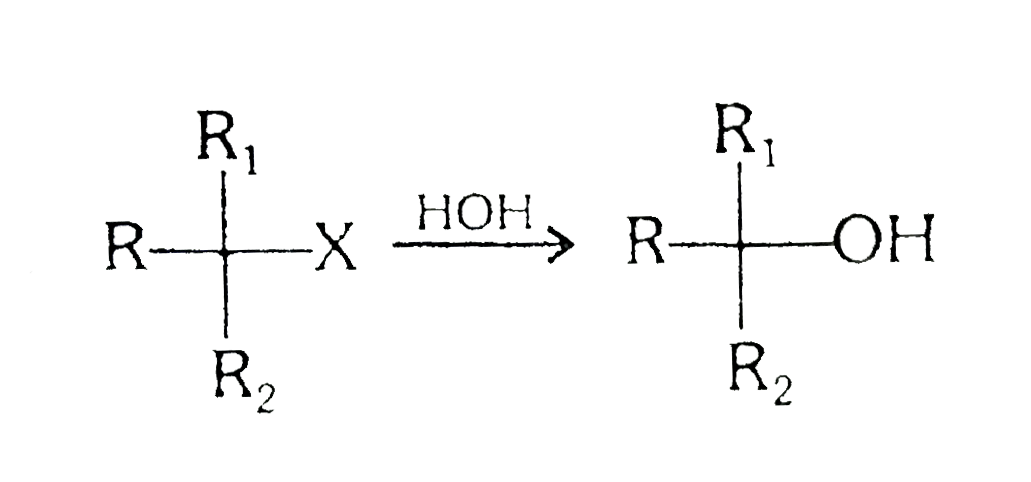The specific rotation of a pure enantiomer is +10∘. What will be its observed rotation if its is isolated from a reaction with
i. 30% racemisation and 70% retention.
ii. 70% racemisation and 30% inversion.
a. i. [α]obs.=0.70×(+10∘)=+7.0∘
ii. 30% inversion, with inversion specific rotation is (−10∘).
∴[α]obs.=0.30×(−10∘)=−3.0∘
b. Optical purity (OP) of sample =[α]obs.[α]D
=−10∘×100−20∘=50%
So, 50% of the mixtrue consists of (−) enantiomer and 50% is the racemate [i.e., 25%(+) and 25%(−) form]
Total percentage of (−) form =50%+25%=75%
Total percentage of (+) form =25%
c. Optical purity (OP) of sample =+9∘+12∘×100=75%
The mixtrue has 75%(+) and 25% racemic mixtrue [i.e., 12.5%(+) and 12.5%(−) form]
Total percentage of (+) form =75%+25%2=87.5%
Total percentage of (−) form =12.5%
Topper's Solved these Questions
- BOOK - CENGAGE CHEMISTRY ENGLISHCHAPTER - ISOMERISMEXERCISE - Example15videos
ISOMERISM
- BOOK - CENGAGE CHEMISTRY ENGLISHCHAPTER - ISOMERISMEXERCISE - Exercise19videos
ISOMERISM
- BOOK - CENGAGE CHEMISTRY ENGLISHCHAPTER - IONIC EQUILIBRIUMEXERCISE - Archives Subjective28videos
IONIC EQUILIBRIUM
- BOOK - CENGAGE CHEMISTRY ENGLISHCHAPTER - NCERT BASED EXERCISEEXERCISE - Chemical Equilibrium73videos
NCERT BASED EXERCISE
Similar Questions
The specific rotation of a pure enantiomer is +10∘. The observed rotation, if it is isolated from a reaction with 30% recemisation and 70% inversion is
View SolutionThe specific rotation of a pure enantiomer is +16∘. The observed rotation, if it is isolated from a reaction with 25% racemisation and 75% inversion is
View Solution
Knowledge Check
- Question 1 - Select One
A first order reaction is 20% complete in 10 minutes. What is the specific rate constant for the reaction?
A0.0970 −1minB0.009 min−1C0.0223 min−1D2.223min−1
70% of a first order reaction was completed in 70min. What is the half life of the reaction?
View SolutionA partially racemised (+2) 2-Bromooctane on reaction with aq. NaOH in acetone gives an alcolhol with 80% inversion and 20% racemisation .
Find out the rate expression of the reaction.View SolutionAn organic compound P exists in two enantiomeric forms, which have specific optical rotation values [α]=±100∘. The optical rotation of a mixture of these two enantiomers is −50∘. Calculate the percentage of that enantiomer which is in lower concentration in the mixture.
View SolutionPure (R) Mandelic acid
 has specific rotation of 150. If a sample contains 60% of the R and 40% of its enantiomer, the [α] of his solution is. View Solution
has specific rotation of 150. If a sample contains 60% of the R and 40% of its enantiomer, the [α] of his solution is. View SolutionCalculate the mass of potassium sulfate required to prepare its 30% solution in 100g of water.
View SolutionNucleophilic aliphatic substitution reaction is mainly of two types: SN1 and SN2. The SN1 mechanism is a two step process. Reaction velocity of SN1 reaction depends only on the concentration of the substrate. Since product formation takes place by the formation of carbocation, optically active substrate gives (+) and (-) forms of the product. In most of the cases the product usually consits of 5−20% inverted product and 80−95% racemised species. The more stable the carbocation, the greater is the proportion of racemisation. In solvolysis reaction, the more nucleophilic the solvent, the greater is the proportion of inversion.
For the gives reaction,
Which substrate will give maximum racemisation?View SolutionIf the height of a tower and the distance of the point of observation from its foot, both are increased by 10%, then the angle of elevation of its top remains unchanged.
View Solution

